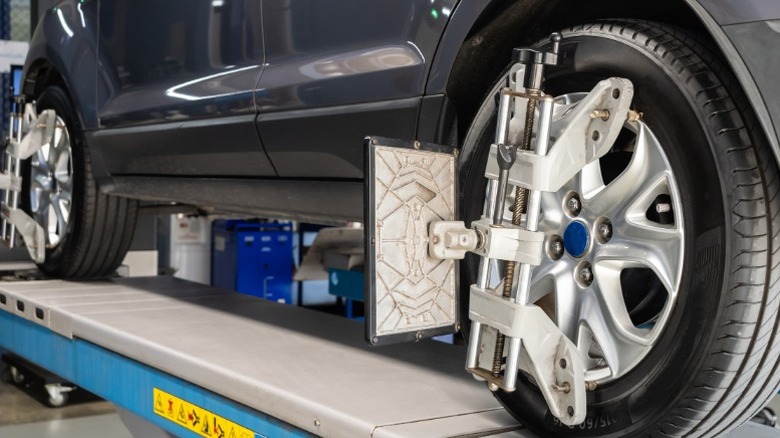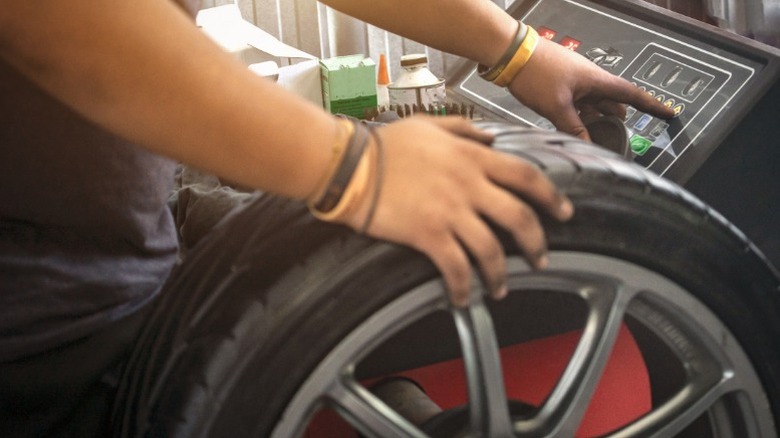What Does Tire Cupping Look Like, And Can It Be Fixed?
Tires are an essential part of your car's anatomy. They're responsible for gripping the road and maintaining traction, as well as for helping to support the vehicle and improve ride quality. They're also some of the most expensive automotive components that require regular maintenance and replacements. On average, drivers can usually expect to get between three and five years or 36,000 to 60,000 miles of life out of their tires. With one new tire ranging in cost from around $80 to upwards of $500, replacements can be a burdensome expenditure. That burden can become even more debilitating if it takes you by surprise, which is why it's so critical that you take the proper steps to care for and protect your tires.
Unfortunately, various issues — including things like suspension system damage and improperly balanced tires — can reduce the life of your tires. Tire cupping, in particular, is a common and serious problem that can drastically shorten your tires' lifespan. A tire with cupping looks like someone has cut out rounded chunks or "cups" out of the tread every few inches along the tire's diameter. Those chunks sometimes look like scallops, leading some people to refer to the issue as "scalloped tires." Tire cupping is relatively easy to diagnose, thanks to that distinctive appearance. However, pinpointing the cause of tire cupping can be more challenging.
Fortunately, as a former professional mechanic who specialized for years in suspension, steering, and tire issues, I'll can explain everything you need to know about tire cupping. We'll go over the potential causes and fixes and explain what your next steps should be if you experience the problem yourself.
What causes tire cupping?
As mentioned, it can be pretty obvious when your car has a tire cupping problem. However, it's often challenging to identify the root cause of the issue. That's because a handful of problems and malfunctions can cause tires to cup. Generally, cupping is the result of a tire moving irregularly over the ground. This causes the tire to hit the pavement unevenly as it spins, which, in turn, results in patches or "scallops" of uneven wear.
Some of the most likely culprits include improper wheel alignment, damaged suspension system components, incorrectly balanced tires, and poor quality tires. Each of these issues can cause tire cupping on its own. However, these problems can also be interconnected, and when one is present, it's likely that it's not the only issue at play.
Proper wheel alignment and frequent tire rotations are crucial to prevent uneven wear. If your tires are improperly balanced, they may hit the road unevenly, which can lead to cupping. Misaligned wheels, on the other hand, can throw off the angle at which your tires sit or spin on the pavement, leading to uneven tire wear and cupping, among other problems. Damaged or faulty suspension components, like shocks and struts, can also be to blame for cupping issues. When these parts fail or wear out, your car is significantly more likely to bounce and ride unevenly, potentially leading to uneven tire wear and cupping. Finally, if you buy extremely cheap tires, you may be more likely to experience issues with tire wear. That's because cheaper, lower-quality tires don't provide the same levels of support and are often built with poor-quality materials, leading to shorter lifespans and the risk of wear problems.
What are the non-visible signs of tire cupping?
As mentioned, one of the most obvious signs of tire cupping is the appearance of missing chunks or "scallops" of tread along your tire's diameter. However, that's not the only symptom you may experience if you have a tire cupping issue, and if you have only a minor cupping problem, you may have to rely on some of the other symptoms to tell you that something is wrong.
Besides obvious signs of wear on the tires, cupping can cause things like a loss of traction, reduced stability and handling, and loud noises. The reduction in traction, stability, and handling comes as a result of the inconsistent tread depth and lack of grip that's liable to occur when tires cup — you may notice that your ride feels bumpy, or you may experience excessive vibrations while driving. Cupped tires can also create some pretty unpleasant sounds, and you may notice a rumbling or droning noise if you have a tire cupping problem. These noises are similar to the sounds you may hear if you have a worn-out wheel bearing, so it's important that you diagnose the problem correctly to avoid replacing unnecessary parts. One way you can differentiate between a bad wheel bearing and a tire with cupping is to raise the car off the ground using an automotive jack and spin the wheel. If the bearing is bad, you'll likely hear a grinding or rumbling noise. However, if your tire is cupped, you'll probably notice inconsistencies in the tread as it spins.
How to identify the cause of tire cupping
There are some ways to narrow down the list of potential culprits if you experience tire cupping. However, you'll need to visit a professional shop for many of these methods. If you're a car pro, you can check your alignment the old-fashioned way. However, even most experienced DIYers and home mechanics need to visit a shop for alignment checks. The same applies to balancing tires, as most people require a professional machine to perform the service properly. That said, these services are great ways to rule out potential causes of tire cupping, and they're extremely important for your vehicle, regardless of whether you currently have cupping issues.
If you visit a shop for an alignment check, the technician will probably inspect your suspension, too. However, you can also check the suspension system yourself. Worn-out shocks and struts commonly cause tire cupping, and you can check these components by inspecting them visually for damage or bouncing your car up and down. If the car bounces excessively while driving or during your inspection, you may need to replace your shocks or struts. Other suspension issues — like a bad wheel bearing — can sometimes cause tire cupping, too. So, you should check the entire system if possible. Remember that poor-quality tires can also cause cupping. Do your research when buying new tires and look for quality products that come backed up by a warranty.
Finally, don't forget that these issues can be interconnected or caused by another problem. For example, your wheel alignment may be off if you have a bad tie rod, or if you damaged a component after hitting a pothole. A professional inspection is the best way to identify the cause of tire cupping definitively, and you should consider visiting a pro if you experience the issue yourself.
Can tires with cupping be fixed?
If you're unlucky enough to experience a tire cupping issue yourself, you'll probably wonder if it's possible to fix the damage instead of buying a whole new set of tires. It's a good question, as new tires can be extremely pricey, and buying a new set prematurely can be a huge financial inconvenience. However, the answer to the question depends almost entirely on how bad the damage is.
You can sometimes fix very minor tire cupping problems by addressing the root cause. For example, balancing your wheels properly and rotating the damaged tire to a less important position — like the rear passenger location — can often fix the issue. Replacing worn-out shocks or struts, realigning your wheels, or dismounting and remounting the tires can also sometimes help repair a tire with cupping.
However, if your tires are severely cupped — i.e., if they're missing large and extremely visible chunks or "scallops" of tread — there really isn't much you can do. You shouldn't shave off the remaining tread to make the tires flat and level again, as that will dramatically reduce the tires' ability to provide solid grip and traction. And if you keep driving with cupped tires, your vehicle's handling may suffer dramatically.
Unfortunately, if you have tires with serious cupping, you'll need to replace them. That usually means buying a minimum of two new tires, as replacing the tire on only one side of the car can cause various problems with handling and the suspension and steering systems. If your tires are new and one of them cups, you may be able to get away with replacing only the affected tire. However, you'll still need to fix the root cause of the cupping problem, as it can quickly ruin a new tire if left unaddressed.
What to do if your tires are cupping
If you end up facing a tire cupping issue, you might find yourself feeling overwhelmed and discouraged. It's true that you should avoid driving if you have a tire cupping problem. Doing so puts you at risk of losing control of the vehicle, thanks to the reduced traction, stability, and handling that frequently accompany cupping issues. If the cupping is very minor, you can keep driving until you're able to address the problem. However, unless you pay extremely close attention to your car's tires, you're unlikely to notice cupping in its early stages.
If your tires are severely cupped and you're able to do so, you should visit a professional mechanic as soon as possible. You can follow the steps outlined above to try to narrow down the list of potential culprits, but unless you're a car pro, you'll still probably have to visit a repair shop to fix the problem properly. If you can't visit a mechanic right away, you should try to avoid driving until you're able to address the issue. It may be inconvenient, but it's better than getting into an accident or developing worse mechanical damage.
Because tire cupping can be such a severe and costly condition, it's vital that you take steps to avoid it and the expenses that often come with it. That means keeping up with routine maintenance and regularly performing things like tire rotations and wheel alignments. These services usually aren't free, but they cost substantially less than a new set of tires, and having them done routinely can save you a lot of stress and cash.





